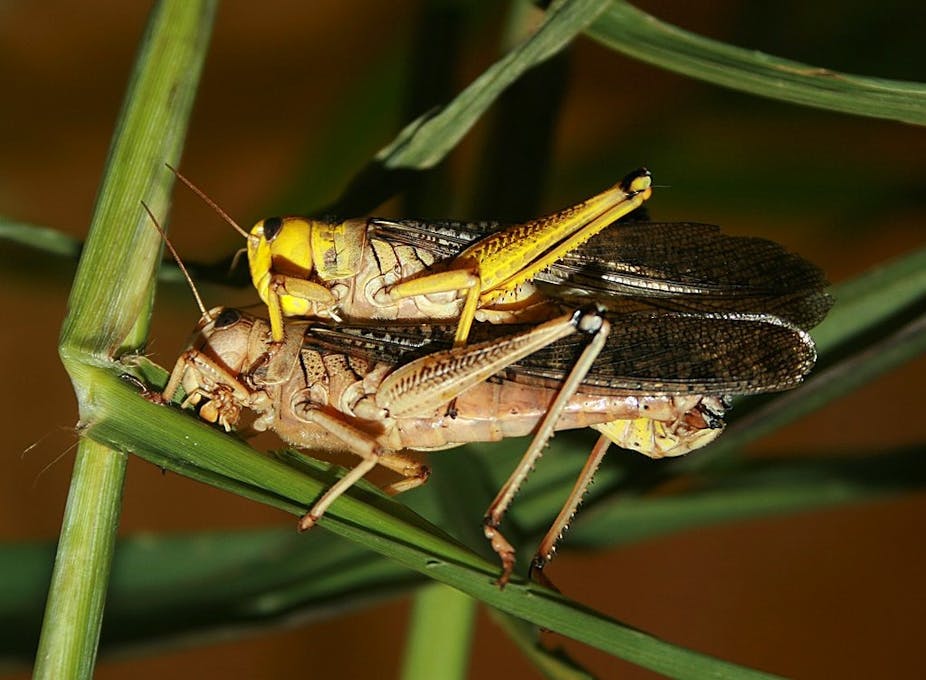Few of us consider that having sex could result in a violent, instantaneous death. But in nature, where sex and violence are often two sides of the same coin, many animals are routinely subjected to such risks.
We evolutionary biologists recognise these risks as part of the “cost of reproduction” – just one of the ways in which having sex and attempting to produce offspring can be costly. These costs are, in turn, thought to have an important role in shaping the evolution of animal reproductive schedules and behaviours. (Having offspring, for instance, is known to shorten the lifespan of a range of animal species.)
Observing and measuring time- or resource-based expenses due to sexual reproduction is relatively easy. We can, for instance, measure the time “lost” due to having to find or choose a mate, or the quantity of resources allocated to the advertisement of gender or mate quality (in peacocks, for instance, the investment is high).
But evidence for the increased risk of being preyed upon (“predation”) due to sex itself has proven particularly hard to come by.
This is because copulation in the wild is generally a secretive and fleeting event, as is predation in the wild. As a result, observing both copulation and predation simultaneously is the biological equivalent of seeing the planets align.
Fortunately, under some circumstances, and often for fleeting periods, the predation costs of reproductive behaviour are displayed in their true brutality. I recently stumbled across an opportunity to witness these little-seen costs being levied upon swarms of mating Australian plague locusts (Chortoicetes terminifera).

The predator in this case was the parasitic digger wasp (Sphex cognatus) which usually preys upon locusts when the latter become abundant in early summer throughout western Victoria.
These wasps actively hunt down locusts, which they then paralyse using a powerful neurotoxin. The wasps take their incapacitated prey deep underground to a larval brood chamber where the locusts are buried as a “living lunch”.
I observed female digger wasps frequently capturing locust prey in mid-December 2010, a time when locusts were swarming at ultra-high densities. Interestingly, as I watched individual wasps return from their hunting forays, I noticed they had often snared copulating pairs of locusts.
Further, using both transect- and quadrat-based census techniques, I found copulating (as opposed to single) locusts to be roughly ten-times less abundant in the broader locust population than expected, based on their incidence as wasp prey.
We can infer from this that wasps were preferentially capturing copulating locusts. This subsequently imposes a cost of reproduction on the locust population, because being “in-copula” significantly raises the instantaneous risk of death. This doesn’t mean locusts should refrain from mating per se, but it is likely to affect, for instance, promiscuity and lifetime mating rates within the locust population.
Predation costs to mating are assumed to apply across many animals, but convincing demonstrations of these costs in the wild are currently limited to water striders and flies.
In my observations, perhaps the unusually high density of locusts revealed an effect which normally operates but is effectively “sub-clinical” to science. That is, I might have seen something too rare and too dispersed to realistically observe under normal conditions.

It is not possible to know whether the capture of locust pairs by digger wasps represents a dedicated strategy by female wasps to catch the largest possible prey items (two for the price of one). An alternative is that this strategy arose merely as an incidental byproduct of the pairs’ reduced escape capacity. That is, mating locusts trying to escape a predator are slower than a lone locust.
Either way, the outcome for locusts of both genders is death – the complete sacrifice of reproductive potential. For male locusts, this cost seemed particularly poignant for two reasons.
First, solo males were never targeted by hunting wasps, and therefore appear virtually immune to this potential source of predation. Second, males that were captured “in-copula” were seen to remain un-parasitised and fully active through the entire capture and provisioning process.
This was probably because they were not stung by the wasp. Indeed, males appeared to be effectively ignored by the female wasp throughout the entire burial process, which ultimately culminated in the male locust being buried alive alongside their paralysed female partner.
In a personification of what is perhaps a male’s worst and most ironic nightmare, male locusts were restrained – and therefore condemned to a violent death – by nothing other than their genitalic attachment to their paralysed female mate.
Pat Benatar had it right: love is a battlefield.
Further reading:

